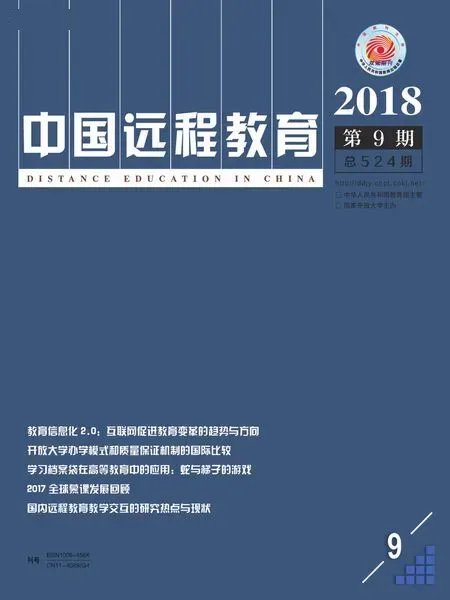英文摘要
OU operating models and quality assurance mechanisms:An international comparison
Weiyuan Zhang,Xiaoxia,Wang and Qingsong Xie
Along with increasingly widespread use of Internet technology in education comes diversification in the operating model of open universities(OUs).This study set out to compare six OU operating models and their quality assurance mechanisms,including(i)public and government-funded OUs,(ii)public but self-financing OUs,(iii)private,for-profit OUs,(iv)private,not-for-profit OUs,(v)private OUs funded by conventional university consortium,and(vi)cross-border,not-for-profit OUs.Six OUs were selected for the purpose of this study,each representing one operating model,including the Open University UK,the Open University of Hong Kong,the University of Phoenix,the Open University of Malaysia,Open Universities Australia,and Virtual University for Small States of the Commonwealth.Findings from the comparison indicate that the development of OUs in the world is characterized by diversification in terms of operation,mission,financial sources,and commitment toquality assurance.
Keywords:open university;online education;quality assurance;comparative study
A study of innovation in OU operating mechanism
Wenhui Lu and Shaohong Zheng
Reform and innovation in the operating mechanism is essential to the transition of the radio and television university to the open university(OU).OU operating mechanism is manifested in the interdependent relationships of its core operating functions and principles,which can be examined from the micro,meso,and macro levels.Innovation in OU operating mechanism should be in alignment with its construction and development objectives in the new age,with the aim of motivating and facilitating OU development.Innovation in OU operating mechanism is an inevitable outcome of the interplay of external and internal forces.Put it more specifically,OUs need to innovate in the following areas:talent cultivation/education,instructional management,system collaboration,social service,and research,coordinating stakeholders and balancing their demands for interests.
Keywords:open university;radio and television university;operating mechanism;talent cultivation;instructional management;system construction;transition;innovation
The learning portfolio in higher education:A game of snakes and ladders
Darina Scully,Michael O'Leary and Mark Brown
The learning portfolio is often lauded as a powerful pedagogical tool,and consequently,is rapidly becoming a central feature of contemporary education.This paper synthesizes and critically reviews the literature pertaining to its use in higher education contexts specifically.A number of key themes are identified and discussed.Although the theory underlying the use of learning portfolios is promising,robust empirical evidence supporting their effectiveness remains sparse.In addition,the tool is rooted in a complex pedagogy,and its potential can only be realized if the processes underlying this pedagogy are properly understood by advocates and executed by users.Finally,there appears to be a recurring tension between the developmental(“process”)and evaluative(“product”)conceptualizations of the learning portfolio.On the basis of these findings,some recommendations for future research and practice in this area are identified.
Keywords:ePortfolio;higher education;assessment;reflection;lifelong learning;badging
MOOCs around the world in 2017
Yu Wang,Shufang Luo,Yizhou Fan and Qiong Wang
2017 witnessed steady increases in the number of MOOC learners,courses and partner universities.A review of the development of MOOC in 2017 indicates that there are three changes.First,MOOC platformswereincreasinglycommercial,tryingto maximizeprofitsandensuresustainabledevelopment through adjustment of business mode,replacement of management or extension of product line such as B2B.Second,vocational training and continuing education became an important direction for MOOC development.By offering microcredentials,involving industry leaders in course design,and providing blended learning model,MOOC platforms aimed to improve in-service learners’professional competence and enable their career development.Finally,the integration of MOOCs and universities and their mutual adaptation were still underway.On the one hand,great progress was made in online degree programs jointly offered by platforms and universities.On the other hand,MOOCs were increasingly combined with on-campus instruction.
Keywords:MOOCs;Coursera;edX;Udacity;commerciality;lifelong learning
Instructional interaction in distance education:A review of Chinese journal publications(2012-2017)
Yaqian Xu and Li Chen
Previous reviews of hot issues in distance education literature tended to adopt the method of frequency statistics.With the advancement of visualization technology,tools such as CiteSpace,UCINET and NVivo have been employed in reviewing literature in other fields of study.Building on previous reviews of DE literature,this study set out to analyze research in DE instructional interaction in recent years.Using the instruments of UCINET and NVivo,the study examined a sample of 109 journal articles on this theme published in Chinese journals between 2012 and 2017,focusing on their authorship and affiliations as well as key issues.There are several major findings.First,the practice of mentoring has contributed to the legacy of research on this theme and the emergence of an‘invisible academy’.Second,research in instructional interaction practice fails to concentrate on major issues,affecting the dissemination and application of research outcomes.Third,technology advancements have enriched interactional experience and enabled the collection and storage of process data,enabling social interaction,cognitive interaction and affective interaction to become emerging research topics.Interaction process,pattern and quality have attracted more and more research interests.Visualized analysis can better reveal relationships between researchers and present clustering of content.It is hoped that this study may have implications for future literature reviews.
Keywords:distance education;instructional interaction;content analysis;social network analysis;hot issues

